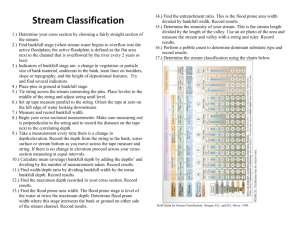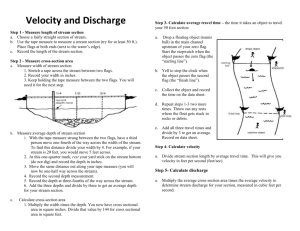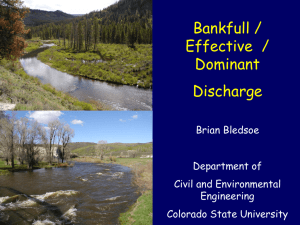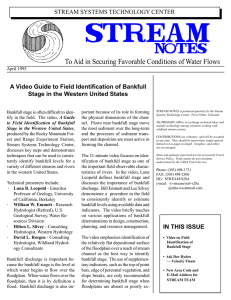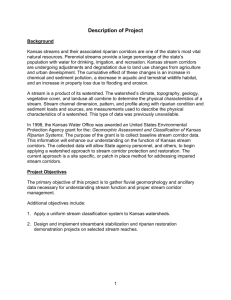land discharges
advertisement
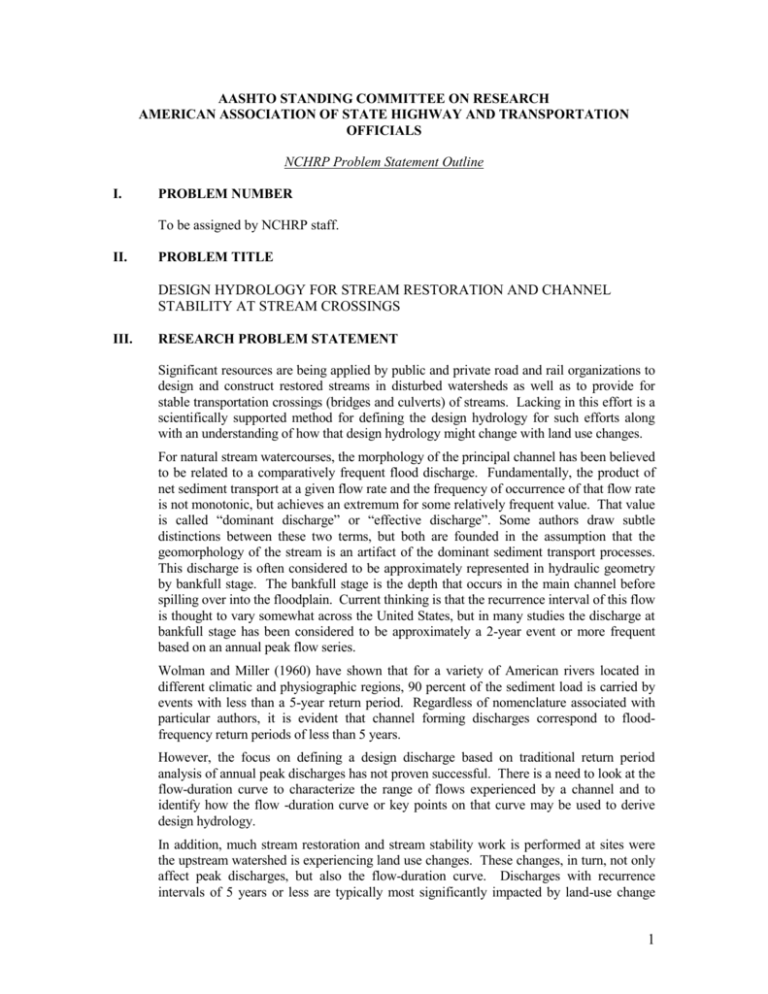
AASHTO STANDING COMMITTEE ON RESEARCH AMERICAN ASSOCIATION OF STATE HIGHWAY AND TRANSPORTATION OFFICIALS NCHRP Problem Statement Outline I. PROBLEM NUMBER To be assigned by NCHRP staff. II. PROBLEM TITLE DESIGN HYDROLOGY FOR STREAM RESTORATION AND CHANNEL STABILITY AT STREAM CROSSINGS III. RESEARCH PROBLEM STATEMENT Significant resources are being applied by public and private road and rail organizations to design and construct restored streams in disturbed watersheds as well as to provide for stable transportation crossings (bridges and culverts) of streams. Lacking in this effort is a scientifically supported method for defining the design hydrology for such efforts along with an understanding of how that design hydrology might change with land use changes. For natural stream watercourses, the morphology of the principal channel has been believed to be related to a comparatively frequent flood discharge. Fundamentally, the product of net sediment transport at a given flow rate and the frequency of occurrence of that flow rate is not monotonic, but achieves an extremum for some relatively frequent value. That value is called “dominant discharge” or “effective discharge”. Some authors draw subtle distinctions between these two terms, but both are founded in the assumption that the geomorphology of the stream is an artifact of the dominant sediment transport processes. This discharge is often considered to be approximately represented in hydraulic geometry by bankfull stage. The bankfull stage is the depth that occurs in the main channel before spilling over into the floodplain. Current thinking is that the recurrence interval of this flow is thought to vary somewhat across the United States, but in many studies the discharge at bankfull stage has been considered to be approximately a 2-year event or more frequent based on an annual peak flow series. Wolman and Miller (1960) have shown that for a variety of American rivers located in different climatic and physiographic regions, 90 percent of the sediment load is carried by events with less than a 5-year return period. Regardless of nomenclature associated with particular authors, it is evident that channel forming discharges correspond to floodfrequency return periods of less than 5 years. However, the focus on defining a design discharge based on traditional return period analysis of annual peak discharges has not proven successful. There is a need to look at the flow-duration curve to characterize the range of flows experienced by a channel and to identify how the flow -duration curve or key points on that curve may be used to derive design hydrology. In addition, much stream restoration and stream stability work is performed at sites were the upstream watershed is experiencing land use changes. These changes, in turn, not only affect peak discharges, but also the flow-duration curve. Discharges with recurrence intervals of 5 years or less are typically most significantly impacted by land-use change 1 such as urbanization, surface mining, removal of trees, and varying agriculture practices. In addition to peak flow values, considerable changes to flow duration relationships and total runoff volume can occur with changes in watershed character. For example, conventional wisdom is that urbanization usually involves the clearing of natural vegetation and replacement with impervious cover such as rooftops, roadways, parking lots and sidewalks and increases the volume of flood runoff. Furthermore, “improved” stream channels through straightening or lining, curb-and-gutter streets and storm drains or sewers are thought to cause more rapid and dramatic watershed response to particular storm characteristics. Sauer and others (1983) showed that impervious cover of 30 percent and moderate engineered alteration of stream channels would approximately double the magnitude of discharge associated with a 2-year recurrence interval. Such increases in flow rate and flow volume implies related increases in net sediment transport potential. Conversely, diminished magnitude of frequent flows may result from a number of anthropogenic activities. Agricultural water conservation activities such as contour plowing, terracing, pumping from valley alluvium, and structural control such as flood control and water supply reservoirs can all result in dramatic reduction in both peak flow rate and flow duration associated with frequent events. The net result of diminishing flow would obviously be a reduction in net sediment transport potential and sediment throughput. Either increases or decreases in net sediment transport potential imply some similar change in the character of channel-forming discharge, consequently affecting both geometry and stability of existing stream channels. Many watersheds are impacted by the land-use change. Changes in the character of frequently occurring event hydrographs imply that changes will also occur in the net sediment transport rates out of a watershed, and local changes in available stream power. The effects of these changes are unknown, but are thought to imply potential changes in state of sediment throughput relationships. Research is needed to quantify the effects of land-use change on the channel forming discharges, and resulting channel geometry, that are important in designing culverts and bridges for long-term performance. The evolution of the stream channel is important to the design of culverts and bridges. If the stage-discharge curve of a bridge or culvert rises significantly more rapidly than the adjacent stream reach, stream power is diminished and local aggradation of the stream often occurs, reducing the effectiveness of the stream and the structure. If the stage-discharge curve of the structure does not rise as rapidly as that of the stream, it may serve as an obstruction, resulting in increased channel velocities and stream power that may lead to local stream degradation and instability. As a result, many State DOTs are designing these hydraulic structures to be consistent with bankfull or effective discharges. IV. LITERATURE SEARCH SUMMARY A body of literature exists from the environmental and geomorphological communities that deal with this topic. David Rosgen (1985-1994, numerous publications) has developed a system of classification of stream morphology that is based on "bankfull" metrics such as stage, width, discharge, and ratios of these metrics. Wolman and Miller (1960), Leopold, Wolman, and Miller (1964), Leopold (1994) expounded upon the concept of "bankfull" and it's meaning in terms of the physical morphology of a stream. See the bibliography of Rosgen "Applied River Morphology" for an extensive concatenation of sources on this subject. 2 Federal Interagency Stream Restoration Working Group, 1998, Stream Corridor Restoration: Principles, Processes and Practices, U.S Department of Agriculture, Washington, DC. Sauer, V.B., Thomas, W.O., Jr., Stricker, V.A., and Wilson, K.V., 1983, Flood characteristics of urban watersheds Wolman, M.G, and Miller, J.P., 1960, Magnitude and frequency of forces in geomorphic process: Journal of Geology, 68: 54-74. V. RESEARCH OBJECTIVE Investigate flow metrics other than peak annual flood frequency curves for more consistent correlation with channel forming processes (such as distribution of daily mean discharge, flow duration, key points on a flow-duration curve, etc). Develop quantitative methods for estimating the impact of land-use change on the design metric that is appropriate for design. Investigate the connection between these changes and changes in channel-forming discharge, and consequently bankfull channel hydraulic geometry. These methods should include changes due to urbanization, surface mining, agriculture and forestry practices. Key Words: Bankfull stage, bankfull discharge, dominant discharge, effective discharge, land-use changes, channel forming discharges, flow-duration curve. VI. ESTIMATE OF PROBLEM FUNDING AND RESEARCH PERIOD Recommended Funding: $ 400,000 Research Period: 30 Months VII. URGENCY, PAYOFF POTENTIAL, AND IMPLEMENTATION This research would set national standards for estimating the hydrology for bank stabilization design and bridge protection. For several years state bridge engineers have been asked or mandated to use shallow flow structures to repair, reinforce embankments near structures at river crossings. These structures are designed for the bankfull flow. The bankfull flow is not very well defined and varies according to researchers and practitioners. This research would establish clear parameters for the bridge designer. VIII. PERSON(S) DEVELOPING THE PROBLEM AASHTO Technical Committee on Hydrology and Hydraulics Will Thomas IX. PROBLEM MONITOR Michael Fazio AASHTO Technical Committee on Hydrology and Hydraulics, X. DATE AND SUBMITTED BY 3 8 September 2008 AASHTO Technical Committee on Hydrology and Hydraulics 4


